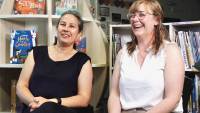Team Teaching Success at Mt Barker South Primary School
What happens when two passionate Year 5/6 teachers join forces to create a truly integrated literacy programme? At Mt Barker South Primary School in South Australia, Renee Saldhana and Ra Te Whare have discovered the transformative power of collaborative teaching that puts student growth at its heart.
Building Confident, Independent Learners
The most striking celebration this year has been watching their students develop genuine independence and confidence in their learning journey. Rather than settling for comfortable choices, students are now actively seeking books that stretch their abilities—not just in reading fluency, but in comprehension and critical thinking skills like inferring.
"We particularly saw this term where they were choosing books that really stretch their abilities," explains Renee. "They're able to have those conversations and work across the two classes, joining each other for book chats."
These cross-class book discussions have become a highlight for students, creating a rich community of readers who support and challenge each other's thinking.
The Power of Connected Learning
The secret to their success lies in the seamless integration of reading and writing instruction. Every unit is carefully planned so that students read within a genre before writing in that same genre, creating meaningful connections that help learning "stick."
"We make sure when we meet weekly that they are matching, that they are linking," says Ra. "It's very rare that they're not connected."
This approach extends beyond simple genre matching. When studying informative texts, students read informative pieces during reading workshop to understand author's craft, then apply those insights to their own writing. The result is a holistic literacy experience where reading informs writing, and writing deepens reading comprehension.
Daily Monitoring and Responsive Teaching
Growth doesn't happen by accident—it requires constant attention and adjustment. Both teachers monitor their students' reading and writing daily, with some students receiving more frequent check-ins based on individual needs.
The introduction of online writing documents has revolutionised their feedback process. Students can receive instant, written feedback that they can immediately act upon, creating a responsive cycle of improvement.
"They go back to that same document online and they can see our feedback there that they can immediately action for change," Renee explains.
Peer feedback plays an equally important role. Students have been explicitly taught how to give constructive feedback on accuracy and fluency, creating a classroom culture where learning is everyone's responsibility.
Structured Independence Through Choice
The 20-minute independent reading sessions aren't passive affairs. While students engage in sustained reading, teachers are actively conferencing, running small group discussions, and providing targeted support. This structured independence gives students agency while ensuring they receive the guidance they need.
The choice element is crucial for senior primary students. In the final weeks of units, students can choose to extend existing pieces or explore entirely new directions. This flexibility honours their developing maturity and prepares them for the increased independence they'll need in high school.
The Magic of True Collaboration
What makes this partnership extraordinary isn't just that two teachers work together—it's how they work together. They plan weekly, but more importantly, they engage in constant, reflective dialogue about their practice.
"We talk daily," Renee shares. "There is a lot of conversation between us about how that lesson went. We do a lot of reflecting, and we do a lot of reflecting in front of the students as well because we want to model that reflective practice."
Their collaboration extends into the classroom itself. One teacher might lead a lesson while the other scribes, creating powerful modelling opportunities. They seamlessly support each other, jumping in to add insights or take over when needed.
Tools That Support Learning
Rather than relying on commercial programs, Renee and Ra create their own tools based on student needs. Their large modelling books serve as anchor charts that students can reference throughout units. Planning templates, editing checklists, and goal-setting sheets help students take ownership of their learning journey.
These tools aren't just teacher resources—they're shared with students as scaffolds for independence. Students learn to use editing processes, track their reading progress, and identify personal learning goals.
Responsive Planning for Every Cohort
Perhaps most importantly, these teachers understand that effective literacy instruction can never be "one size fits all." They're already thinking about their next year's cohort, recognising that each group of students brings unique needs, strengths, and interests.
With ten continuing students and fifty new ones joining their classes, they know they'll need to learn who their students are before determining exactly how their successful framework will adapt.
The Takeaway
The success at Mt Barker South Primary School demonstrates that when teachers truly collaborate—sharing planning, teaching, and reflection—students thrive. By connecting reading and writing, providing choice within structure, and maintaining a relentless focus on individual growth, these educators have created a carefully curated iteracy programme that celebrates every student's journey towards becoming confident, independent learners.
Their story reminds us that the most powerful teaching happens when we work together, stay responsive to our students' needs, and never stop reflecting on how we can do better.
See the video here

